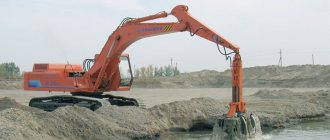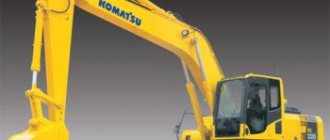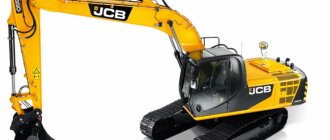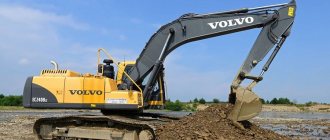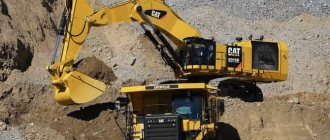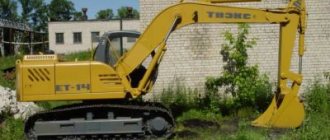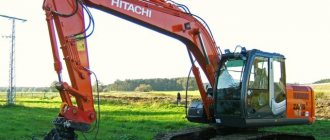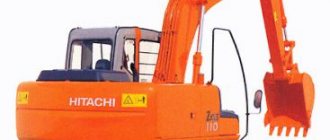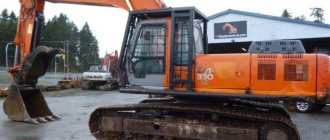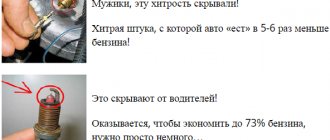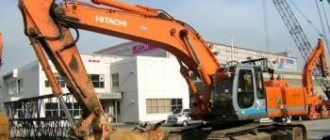About the manufacturing company
Currently, the EK-18 manufacturer, the Tver Excavator Plant (TVEX), is part of one of the leading machine-building companies in Russia. It specializes in construction and road equipment and unites 4 plants: Tver Excavator Plant, Bryansk Arsenal, Chelyabinsk Road Construction Machinery Plant and Zavolzhsky Tracked Tractor Plant.
Through 78 dealer centers in Russia and the CIS, RM-Terex sells, services and provides spare parts for: backhoe loaders, wheeled and tracked excavators, motor graders, tracked snow and swamp-going vehicles, front-end and fork loaders, industrial material handlers. All manufactured equipment has the official status “Made in Russia”.
The Tver Excavator Plant (during the USSR it was called “Kalininsky”, like the city itself) traces its history back to 1943. Long before the final victory in the Great Patriotic War, construction of a plant began in Kalinin to produce spare parts and components for excavators, saw shafts, multi-story lifts, other peaceful equipment and consumer goods.
Soon after the end of the war, the company began producing the country's first pneumatic-wheeled excavators with rope suspension (model E-255). In the 1970s, the plant mastered the production of hydraulic wheeled and tracked excavators. In 1978, one of these models - EO-3322B - was awarded the State Quality Mark. In March 1981, the fifty-thousandth excavator rolled off the production line of the enterprise, and the plant was awarded the Order of the Red Banner of Labor for replenishing the national economy with reliable and productive equipment.
TVEX traditionally uses Minsk engines. Most of the other units, assemblies and components of excavators are produced directly at the Tverskoy Excavator Plant, even in our time. According to statistics, more than 90% of special vehicles produced at the plant are equipped with domestically produced hydraulics and Belarusian diesel engines, and only about eight percent are produced with Bosch-Rexroth hydraulics and imported Perkins engines.
Volvo BL71 backhoe loader price
It is no longer possible to buy a new backhoe loader of this model: they were discontinued several years ago. But on the secondary market for special equipment, thanks to the popularity of this model, you can find many offers for the sale of used Volvo BL71 backhoe loaders. Prices vary: from 1,500,000 rubles for equipment manufactured in 2003 to 5,200,000 rubles for a relatively recent model produced in 2015.
Excavator design and device
The EK-18 wheeled excavator consists of the following main components and systems:
- pneumatic wheel running device,
- turntable,
- hydraulic system,
- pneumatic control system,
- electrical equipment,
- working equipment.
The pneumatic wheel running device of the special vehicle is made on 2 drive axles. It is capable of providing a fairly high speed of movement on work sites and on the roads between them, as well as, if necessary, simple and safe towing of the EK-18 with a tractor.
The front axle is controlled. The tires on it are single; the bridge itself is balanced on the running frame. The rear axle is unsteered, gable; is attached rigidly to the running frame. The axles are driven through a gearbox and cardan shafts from a low-torque hydraulic motor. Before excavation work, the excavator rests on folding supports and a dump support to increase stability.
The turntable is attached to a turntable, which is mounted on the running frame. The following are mounted on the rotating platform: a power unit and a diesel fuel tank, a rotating mechanism, an operator’s cabin, a heating and ventilation unit, hydraulic equipment (hydraulic tank, hydraulic valves, oil cooling unit, etc.), elements of electrical and pneumatic equipment, as well as a counterweight.
The working equipment of the EK-18 excavator is installed in the eyes of the turntable and secured with fingers. The design of this special machine provides for the possibility of using all kinds of replaceable working equipment and working parts. In addition to the backhoe, this includes a grab, hydraulic hammer, ripper, hydraulic shears, log grabber, etc.
Additionally, the technological capabilities of the EK-18 are expanded by the front support blade, increasing the degree of versatility of this special equipment. They can be used to fill trenches, clean the soil surface, rake up construction debris, and level the work site.
The drive of all movements by replaceable working equipment, as well as the control of the executive bodies of the excavator and its steering are hydraulic. The control of wheel brakes and parking brake, gear shifting is pneumatic. The EK-18 is equipped with electrical lighting, ventilation, alarm and diesel start systems, and is ready for work at any time of the day and in any climate, while maintaining normal operating conditions in the cabin.
Features of the Volvo BL71 backhoe loader
The design of the backhoe loader is as follows. The units consist of the following main mechanisms and systems: swing support system; chassis; outrigger; rotating platform; arrows; handles; ladle; hydraulic cylinders and pumps; bulldozer blade. It is possible to connect hydraulic shears, hole drills and (or) other attachments.
One of the main features of this model is the use of a loader joystick, which is controlled with one hand. With its help, you can change the gear, the direction of movement of the tractor and disconnect the transmission.
The Volvo BL71 is characterized by high stability on loose soil due to its low ground pressure. Another important technical feature of this excavator is the modern “closed center” hydraulic system, which ensures extremely precise coordination of the movements of all working equipment. The installed torque converter helps to perform precise actions during the collection of bulk soil and its careful reloading.
Easy access from the ground to a small number of lubrication points allows routine maintenance of the machine to be carried out as quickly as possible.
For Volvo backhoe loaders, the Volvo CareTrack function was specially developed - a combination of telematics and diagnostic systems to transmit current information about the location of the special vehicle at the current time to any external computer.
Also, the basic equipment of the special vehicle can be supplemented with a “soft suspension” of the loader boom, which protects the hydraulic system and ensures smooth operation, and therefore prevents spillage of materials when moving at high speed over rough terrain.
Pneumatic undercarriage and slewing ring
The EK-18 undercarriage includes: undercarriage frame with a slewing ring; folding supports + blade support; gearbox, front and rear axles, which are connected by cardan shafts; wheel turning and control mechanism; a central manifold, which is connected by pipelines to the gearbox hydraulic motor, folding support hydraulic cylinders and blade support hydraulic cylinders, as well as to the components of the pneumatic control system: built-in air receiver, wheel brakes, parking brake, gear shift mechanism.
The rotary support device on excavators of this model is a bearing-type rotary support: roller, single-row, with internal teeth. The platform rotates using a low-torque axial piston hydraulic motor with a 2-stage planetary gearbox. It increases torque and reduces turntable speed.
Gearbox and brakes
The EK-18 gearbox is used to transmit torque from the hydraulic motor to the drive axles; to change gears, turn on/off the front axle and prevent the excavator from spontaneously starting to move (applying the parking brake). The gearbox consists of a hydraulic motor, a 2-speed gear transmission, a gear shift mechanism, and a parking brake. The excavator axles are equipped with pneumatic shoe brakes.
Parking brake EK-18 is a permanently closed type, with pneumoelectric control. Gear shifting can only be done after the excavator has come to a complete stop. The pneumatic system of the special vehicle is involved in the operation of the brakes, in shifting gearboxes, and in turning the front axle on/off.
Bridges
The rear axle of an excavator of this model includes a main gear, a housing, wheel hubs with parts located in them (planetary gear, axle shafts, bearings).
When the EK-18 moves straight on a flat road, the drive wheels on the right and left travel equal distances. When turning, as well as when driving on uneven ground surfaces, the drive wheels of the excavator, which move along the inner radius and experience great resistance, rotate more slowly than the wheels that move along the outer radius and experience less resistance.
The wheel steering control mechanism consists of a system of levers, longitudinal and transverse rods, which ensure the rotation of the special vehicle both when driving independently and when it is towed by a tractor.
Advantages
Chinese manufacturers of backhoe loaders are a fast competitor in the construction equipment market.
There are a number of significant advantages that this technique has:
- Application of advanced European technologies in the manufacturing process. The quality of the equipment produced rivals and displaces European and American analogues.
- The cost of Chinese special equipment is much lower than that of European manufacturers.
- Ease of operation and availability of parts on the market.
EK-18 excavator engine
The vast majority of excavators of this model are equipped with diesel engines from the Minsk Motor Plant. In the EK-18-20 modification, this is the MMZ D-245S, with a power of 105 horsepower (at 2200 rpm) and a maximum torque of 384 N.m (at 1400 rpm). In the EK-18-20 modification – MMZ D-245.2S2, developing 122 horsepower at 2200 rpm and 501 Nm of torque (at 1600 rpm).
MMZ D-245S.
In both versions, it is a four-stroke, four-cylinder diesel engine, with an in-line vertical cylinder arrangement and direct injection of diesel fuel, with turbocharging. The working volume is 4.75 l; cylinder diameter – 110 mm, piston stroke – 125 mm; compression ratio - 17.1.
Imported diesel Perkins 1104C-44TA (modification EK-18-20) - of a similar design. Also inline four-cylinder, equipped with a turbocharging system. Its maximum power is 123 horsepower at 2200 rpm. The working volume of the Perkins engine is 4.4 liters. The cylinder diameter is 105 millimeters, the piston stroke is 127 millimeters. The maximum torque reaches 500 N.m.
The EK-18 excavator can be equipped with a Hydronic-10 (12 V) liquid heater for pre-heating the engine. To warm up the cabin interior in cold weather, the excavator has a Zenit-8000 liquid heater.
Working equipment and hydraulic system
As already noted, the design of the EK-18 excavator provides for the possibility of using this special equipment with various types of replaceable working parts. These include backhoe buckets of various volumes, grab equipment (digging and loading), hydraulic hammer MG-300, hydraulic shears IG-821 and IG-811, concrete crusher, log grabber with a lifting capacity of 3 tons, ripper 225-00-40.17.400 .
The main type of replaceable working equipment - a backhoe - is intended for a wide range of earthmoving and loading / unloading operations. Its components are: a boom, a handle, a replaceable working element, a bucket drive mechanism, hydraulic cylinders, a system of pipelines and high-pressure hoses that connect the hydraulic cylinders to the excavator hydraulic system. Replaceable working parts of the backhoe - digging buckets of different volumes (from 0.65 to 1 cubic meter) and practical purposes.
The hydraulic system of the excavator is designed to drive its power mechanisms: for movement, rotation of the platform, operation of working equipment, outriggers and blade (1st circuit), hydraulic control (2nd circuit) and steering (3rd circuit).
The pump unit is a 3-flow hydraulic drive unit that converts the rotational energy of the drive shaft into the energy of the flow of working fluid. It is equipped with a gearbox; two adjustable pumps and one unregulated.
An adjustable axial piston type hydraulic motor can be used as a travel hydraulic motor. A hydraulic motor with a connecting rod pumping unit for the cylinder block with a flow regulator makes it possible to obtain proportional dependences of volume on pressure.
The gear hydraulic pump is driven by the diesel engine on which it is mounted. Direction of rotation of the pump input shaft: left – with MMZ D-245 engine.
The excavator is equipped with a ten-spool hydraulic valve. It consists of a common plate on which 10 sections are located. Of these: two central sections are pressure and drain sections and eight sections are working sections.
The hydraulic cylinders with which the EK-18 excavator is equipped differ in their design, in nominal and maximum permissible operating pressure, in the diameters of the rod and piston and in the piston stroke. But all hydraulic cylinders consist of the following parts: welded body, rod, front cover, seals. The supply of working fluid occurs through pipelines that are connected to the cylinder body with flanged or threaded connections. The piston divides the internal space of the cylinder into two cavities that do not communicate with each other: the piston and the rod.
All modifications of the EK-18 excavator are equipped with hydraulic power steering.
Purpose
Volvo bl71 and bl61 machines are outstanding representatives of modern special equipment, the design of which incorporates numerous engineering developments and rich research potential. These machines combine the technical capabilities of both excavators and loaders. They are most effective when performing the following types of work:
- digging trenches for pipelines and communication networks;
- digging pits for the construction of foundations;
- construction of artificial ponds and swimming pools;
- development of small deposits;
- carrying out loading and unloading activities;
- movement of solid and bulk materials;
- garbage collection.
Electrical equipment
Electrical equipment EK-18 is responsible for starting the engine, illuminating the work area if necessary, ventilating the cabin, turning on the light alarm when the special vehicle is moving, and for pre-heating the diesel engine. In addition to the starter, consumers of electricity on this equipment are control and measuring equipment, lighting and signaling equipment, electric fan motors, and a motor heater. All current sources and consumers are connected according to a single-wire circuit, in which the metal structure (“ground”) of the special vehicle serves as the negative wire.
Modifications
EK-18 excavators are produced with indexes -20, -30, -40, -44, -60 and -90 (M). The differences between them are buckets of different volumes, different load capacity indicators; in various hydraulics and diesel engines.
- EK-18-20 – with a 1 m3 bucket.
- EK-18-30 – with Bosch-Rexroth hydraulics.
- EK-18-40 – with a grab grip, for loading and stacking logs, pipes, metal; hydraulic lifting cabin and scrap equipment;
- EK-18-60 – with a Perkins engine and Bosch-Rexroth hydraulics.
- EK-18-90 – with a more powerful modification of the MMZ D-245 engine.
Technical specifications in numbers
- Total length – 9.4 m; width – 2.5 m; height – 3.25 m.
- Operating weight – 17.3 tons.
- Bucket capacity – 0.4; 0.65; 0.77; 1 m3.
- The maximum digging depth is from 5.77 m to 7 m, depending on the modification.
- The maximum digging radius is 8.85 m.
- The maximum unloading height is from 6.24 m to 6.72 m.
- Pumping unit power – 51.5 kW (70 hp)
- Pressure in the hydraulic system – 28 MPa (280 kgf/cm2)
- Pressure in the pneumatic system – 0.6…0.7 MPa (6…7 kgf/cm2)
- Total pump flow – 248 (112+112+24) l/min
- Excavator hydraulic system capacity – 335 l Turntable rotation speed – 6 rpm
- Travel speed – 20 km/h
- The voltage in the electrical system is 12 V.
Excavator cabin and hood
The EK-18 excavator is equipped with an all-metal noise and heat-proof cabin. The upper windshield with frame can be removed under the cab roof and fixed in this position. The door is equipped with a lock. There is a lock on the left outer wall of the cab to hold the door in the open position. There is a special vibration-isolating mat on the floor. The cabin has a sprung seat whose backrest can be adjusted. The position of the chair itself is adjustable in depth and height. The excavator hood is made of removable blocks that have hinged doors and panels for easy access to units and mechanisms on the turntable for maintenance and repairs.
Loader No. 939. Front loader after 1500 operating hours
No matter what difficulties plague the road construction equipment market, a wheeled front loader will be needed everywhere and always. And today on the Russian market it is difficult to find machines with a better price-quality ratio than Chinese-made loaders. And not only in Russian. In this market segment, the Chinese have been breaking records for production and sales volumes for several years now. Unless temporary stagnation in the domestic construction market can stop them. The “hero” of our today’s column “Operating Experience” is one of the top 10 companies occupying leading positions in the Chinese front loader market. This is a loader from Shandong Lingong Construction Machinery, abbreviated as SDLG. Our correspondent visited Novosibirsk, where a three-ton model, the LG-936, has been operating for more than a year and found out how well this machine has taken root in Siberian operating conditions.
Passport details
This is how the manufacturer himself characterizes this car. Loaders of the LG-936 series are a new development by SDLG, aimed at European consumers who prefer equipment equipped with units from well-known global manufacturers. The machines are equipped with DEUTZ or Cummins engines, automatic transmissions of our own production and a hydraulic system with Kawasaki elements. We will assume that the acquaintance has taken place. Now let's listen to what those who work on it say about this loader. 1500 engine hours is already quite a long service life so that you can draw some conclusions about the quality of the equipment, its pros and cons. This is exactly how long the LG-936 worked under the control of rental operators. The range of work performed for a loader is the most traditional. In winter - cleaning areas from ice and snow, in summer - working with construction waste, soil, crushed stone and sand. In general, everything that a medium-duty front-end loader has to do in a company that performs the widest range of contracting work. The intensity of use of the LG-936 cannot be called very high. According to the mechanic, the loader operates in single shift mode most of the time. From time to time there are downtimes of several days. At the same time, like any wheeled rental equipment, this loader has to spend a lot of time traveling from one job site to another. Storage conditions are favorable for Siberia: the loader is in a garage, that is, extremely cold starts are unfamiliar to it. But I had to work in 30-degree frosts this winter more than once. Snowfalls this year often gave way to severe cold, so snow removal work often had to be carried out at temperatures of 30-35o C.
Maintenance
According to the factory regulations, maintenance of the LG-936 must be performed every 250 operating hours. At each maintenance, the engine oil and all filters are changed and the loader is injected according to the lubrication chart. After 500 operating hours, the lubrication in the axles, transmission and hydraulic system is also changed. Until now, the loader was only serviced by a dealer because it was under warranty. According to employees, the cost of a complete dealer maintenance is about 10,000 rubles. When changing oils, the official dealer uses only Mobil brand products.
Advantages and disadvantages
Structurally, the LG-936 does not cause serious complaints from its owner. All the main components and assemblies have never failed, and today, after 1500 operating hours, they are in good condition. Of course, one year of work is not yet an indicator. As experts say, the real quality of Chinese technology can only be judged after the second year of operation. This is how its operator Alexander Kovikh characterizes the work of the loader: “If you consider that before this I worked on a Russian backhoe loader based on MTZ-82, then the difference, of course, is significant. Firstly, automatic transmission. There is no need to constantly shift the lever and squeeze the clutch. You just need to move the transmission selector - “back and forth”. This alone makes the work much easier. Secondly, the hydraulics work much faster here, and the cabin is much more spacious and comfortable. I became much less tired at work.” However, it’s probably not worth comparing these two cars - different classes and different prices. In comparison with its classmates, the SDLG loader will not differ much from most of its main competitors - other models from the top 10 Chinese manufacturers. The short description given to this equipment by its owners is as follows: “There are no complaints about the engine, transmission and axles. They work properly if you change the oil and filters in a timely manner. But little things have to be repaired from time to time.” This LG-936 had very few such little things over the entire year of operation. Around the middle of the year, the rear axle oil seal leaked. It was before the next maintenance, and the oil seal was replaced under warranty, free of charge. One more time we had to call an electrician - the halogen lights on the roof of the cabin failed. The problem turned out to be trivial: contact was lost somewhere in the wiring. That's all, except for the bucket teeth that wear out from time to time. It sounds somehow ideal, but Alexander admits that almost greenhouse conditions have been created for the loader. For example, many owners of Chinese forklifts that are not equipped with engine preheating complain about extremely unstable starting in cold weather. If this car were parked on the street, then its operator would have to suffer grief. By the way, about working in cold weather. No matter how much the sellers talk about adapting the loader to Siberian winters, the standard SDLG stove does not cope with its responsibility. Already at -20°C it becomes very fresh in the cabin and covers all the side windows. The operator had to install an additional water heater in the cabin. “This year I had to work in cold weather - 35°C. Naturally, such temperatures affect performance. The hydraulics, the axles, and the hydraulic booster freeze, but everything works properly. Not a single cylinder leaked after this work, not a single hose was torn, which indicates the high frost resistance of the hydraulics,” says Alexander Kovikh. The loader operator notes that over the past year the LG-936 has run on diesel fuel of varying quality. I even had a chance to refuel with “diesel” diesel fuel. The fuel equipment turned out to be indifferent to these experiments. This engine has a regular in-line injection pump, so the “Chinese” is not picky when it comes to the quality of diesel fuel. When purchasing, there were concerns about the service life of the Chinese turbine, but they were not justified. So far the turbocharger does not cause any concern. Separately, it is worth mentioning the quality of the protective layer. The fact is that many Chinese manufacturers are accused of insufficient attention to this issue, which is why even new cars rust like tin cans. As the owner of this loader assures us, he has no complaints about the quality of the paint. All parts of the frame and cabin are pre-primed, the paint itself does not fall off. Only the working parts of the loader rust, and then only after several days of inactivity.
Summary:
The SDLG loader confirms its status as one of the leaders in the Chinese market. Subject to timely maintenance and regular monitoring, it will not present you with unpleasant surprises. The loader works quite successfully in the Siberian climate on Russian diesel fuel, again subject to regular checks of the condition of the fuel filters. The disadvantages include a weak heater and minor electrical problems.
Reviews of EK-18 excavators
In general, owners speak positively about the experience of using equipment of this model. This is a reliable, durable, unpretentious and productive machine. Works accurately and smoothly. There are no serious complaints about its operation. From the comments: the pump is not efficient enough, as a result of which the excavator is rather slow in operation (but this is only for experienced aces; for novice operators such smoothness is more of a plus than a minus). The hydraulics get hot and overheat quite quickly (a larger radiator would be nice). Some operators criticize the EK-18's cabin as not being comfortable enough for today's technology.
Personal review of Hitachi operation
From my experience I will say that I operated a tracked Hitachi ZX250H, which worked for 5 years in a quarry (picking up stones behind a hydraulic hammer, transferring them, throwing them into crushers). The quarry work left its mark on the appearance: the body and cabin were dented, the handle was also loose, the hydraulics were a little shaky, but in general, the excavator behaved with dignity during excavation work in the mountains - a real workhorse!
Category: Articles
